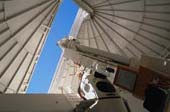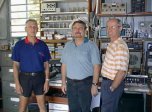

| Home | |
| Who Are We? | |
| What are we Looking for? | |
| How we do it? | |
| Technical Data | |
| Boonah Space Centre | |
| Solar Power Station | |
| What's New | |
| News Flash | |
| Join Us | |
| Fund Raising | |
| Advisory Board | |
| Our Observatories | |
| Download | |
| Links | |
| Bruno Award | |
| Can SETI Succeed | |
| Space Communication | |
| Contact Us | |
| SETI League | |
| Australian Women Scientists | |
| Australian Astronomers | |
| Aust. Astrobiology Institute | |
| Brisbane Planetarium | |
| S.E.T.I@Home | |
| S.E.T.I Australia | |
| Sky & Telescope Seti Site | |
| Invitation to ET | |
| 3D Universe | |
| COSETI website | |
| Universe Today | |
| Space Daily | |
| Space.com | |
| Spaceref.com | |
| Hubble News | |
| Space Flight Now | |
| SpaceToday.net | |
| Liquid Water on Mars? | |
| Science News Online | |
| Physics | |
| Another look at "WOW" | |
| **New** We have recently recorded several files from our new 5 metre radio telescope that came into service during the month of October 2003. The first is an updated observation at 1420mhz, the second is the SUN at 1420mhz and the 3rd is a signal received at 1296mhz. The last one is interesting if you want to do a DSP on it as it has some interesting characteristics. You can even analyze them if you want. The files are here 1420.wav Sun1420.wav and 1296.wav. During the recent E.M.E. amateur radio contest on the 15th ~ 16th November 03 we were able to record some signals whilst pointing our dish at the moon. This is the file we recorded cq1296.wav and a spectrogram of the event is here. Some of these files are large at 3mb others at 1.4mb. Also, download Your Own Audio Analysis Program here. | |
|
|
How We Do It?
The 42 foot dishes were moved onto the site in May 2000 where they have been sitting ready for re-assembly but we will not be mating the dishes to the Heliograph equatorial mounts for some time. Refurbishment and upgrade of the mounts is necessary so that they will handle the increased loads from the larger dishes. We are working hard to prepare the two dishes so that they can be assembled and mounted on three Acro Props just above the ground in "bird bath" mode. This will allow us to get the electronics installed and tested prior to eventual mounting on the towers. The two 42 foot dishes used to form part of a microwave communications network around Queensland for Powerlink, who is responsible for the power distribution throughout the state. We are very grateful for the assistance that Powerlink has given us, especially the 2 large dishes that will form the heart of our array.
Each of the DSP's will be fed the 10MHz wide signal outputs and perform the analysis of what is received. A bank of Pentium computers running software especially designed to look for the signals that we think are buried in the cosmic noise. We will monitor progress on waterfall type displays and record what is interesting. Other software will manage the rest of the analysis systems so we can look back over our data and perchance find something that we may have missed on a previous run. Our software will be searching for signs of extremely weak narrow band signals that could only come from a non-natural source. A transmitter that created the signal artificially and probably produced by another civilization. Because we expect the signals to be very week, we must employ sophisticated mathematical algorithms to detect and amplify the signals that can filter them using ingenious statistical methods. The software will perform a Fourier Analysis on the static, trying to find those telltale signs of artificiality indicating that we may have detected the signal we have been searching for. Computer programs will monitor the output for frequency drifts that may indicate the transmitting source has a velocity, through space, compared to the receiving antenna. If the frequency shift is in an upward direction (increasing) we can say that the source is moving toward us (blue shifted). If the frequency shift is going down (decreasing) we can assume that the source is receding from us (red shifted). This effect is known as DOPPLER SHIFT and is one of the most powerful tools used by both Radio and Optical Astronomers. There is a natural Doppler shift caused by the Earth's movement through the Solar System and also the Sun's movement through interstellar space and also the motion of the Galaxy. This motion causes an interesting frequency shift to be applied to any signal being received from on the Earth. The algorithms used to computer the shifts in frequency due to the accumulation of all these motions is very complicated but thankfully, science has worked out the math's long ago to do this. The known frequency shift can be used as a tool to extract useful information about any potential received signal. By subtracting these effects caused by our motion through space we can pinpoint the position of a candidate signal and attempt to identify its apparent position in space. I would think that another civilization would send the signal without any frequency correction at all. This would allow us to discover certain information about the source of the signal. ie whether it is a fixed source in space or on a planet. Radio Astronomers use these effects to measure the velocity of objects moving through space. This helps us obtain many useful facts about what is happening in and around strange, exotic objects like Black Holes, Super Novas and other little understood phenomena that exist in the far reaches of the universe. We use the Doppler Shift to help decide if a detected signal is coming from a satellite or just local interference from the Microwave oven next door. The art of Radial Velocity measurements as performed in the field of optical astronomy is similar to the Doppler shift experienced in radio astronomy. That characteristic CHIRP with a sliding frequency may be the signature of the signal we have been waiting for.
|




